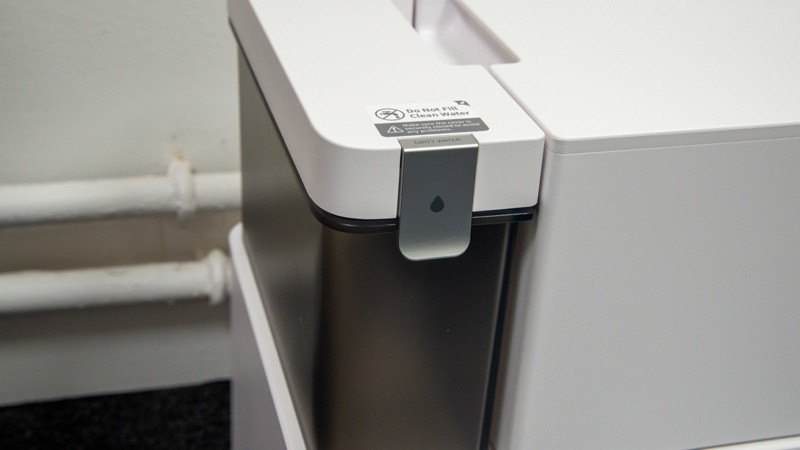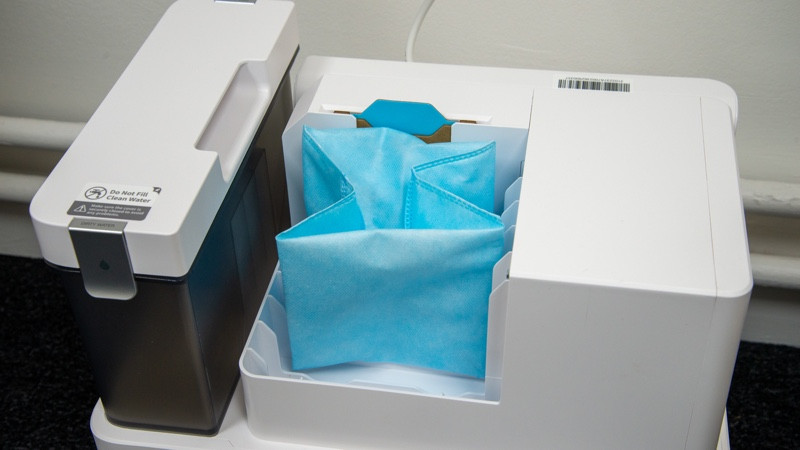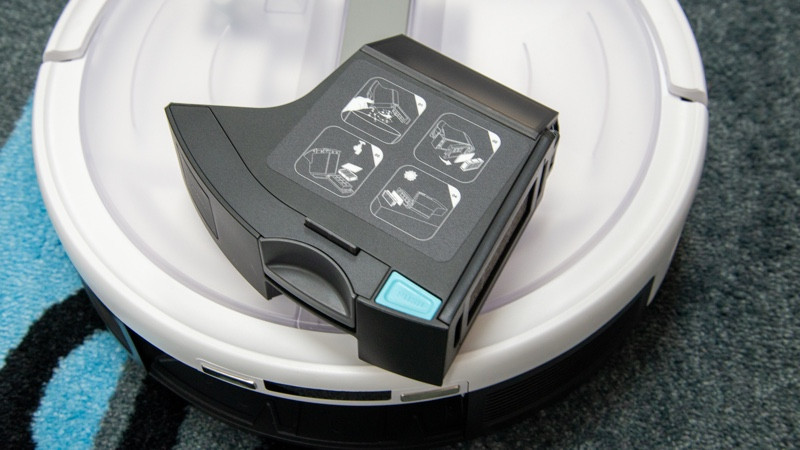Cut price robo cleaner that packs a hefty punch
A clever bit of kit, the Yeedi Cube takes a lot of the technology that’s available in high-end robot vacuum cleaners, including a self-lifting mop and self-cleaning station, and applies them to a product that’s a fraction of the price. Its powerful suction ensures a deep clean, while the clever 1-litre water tank means that there’s enough water to mop large areas. There’s only support for one map, and the mopping isn’t quite as good as on the main rivals, but for those with generally lightly soiled floors, who want to focus on cleaning one floor, this robot vacuum cleaner is great value.
Pros
- Auto-lift mop
- Large water tank
- Powerful suction
Cons
- Limited to one map
- App is a bit basic
Yeedi continues to impress with its range of lower-cost yet feature-packed robots. Its latest, the Yeedi Cube, packs in a robot vacuum and mop, with a self-clean and self-empty station, all for under $700.
Rather than just copy what the higher-end competitors have, the Yeedi Cube does a few things differently, including its 1-litre water tank on top, which provides enough water to clean a huge area.
While there are a few limitations, the robot has enough going for it that it’s a credible rival to the bigger names in robot vacuum cleaners, such as the Roborock S8 or the Dyson 360 Vis Nav.
Read on for our full Yeedi Cube review to find out why…
Yeedi Cube: Design and build
Although yet another round robot, the Yeedi Cube does at least look different thanks to the large 1-litre water tank that clips into the top of the robot.
Rival: Eufy X8 Pro review
That’s quite a staggering amount of water, given that many other robots will have less than half of this. There’s a pull-up handle on top that makes it simple to pull the tank out and refill it with tap water.

(Image credit: The Ambient)
Once docked, the station squeezes out dirty water from the mop (10N of force) and sucks it up into the dirty water tank on the side.
There’s then hot air drying, which prevents odours from building up.

(Image credit: The Ambient)
The end result is that you get many features similar to those on the Ecovacs Deebot T20 Omni, only in a cheaper package and with a smaller station.
As well as cleaning the mopping pad, the docking station also holds a pair of 1-litre bags, sucking dirt out of the robot. Each bag holds around 60 days of dirt, so you’ll only need to swap this out every couple of months or so.

(Image credit: The Ambient)
You can still manually remove and empty the bin too, should you wish.
While you won’t need to do that on a daily basis, cleaning the bin and its filter once a month will help the robot’s suction and cleaning ability.

(Image credit: The Ambient)
Underneath, the Yeedi Cube is a sonic mopping pad, which moves at high speed to agitate dirt, similar to the one on the Roborock S8 Pro Ultra. This mopping bracket can also lift 8mm off the ground, letting the robot traverse carpet and rugs without getting them wet.
There’s a standard floor roller, which isn’t an anti-tangle variant. If you’ve got people with long hair in your home, or pets, you’ll need to cut tangled hair away from time to time.

(Image credit: The Ambient)
Dual side-sweeping brushes are there to tease dirt away from the edge of the room. As they’re on both sides, the Yeedi Cube can approach edges from any direction and still swipe them away.
On top, there’s an upwards-facing camera, which the Cube uses for navigation. While VSLAM is no as fast as LiDAR for navigation, it’s a cheaper system and this robot is an able navigator.
For quick control, there are three buttons on top: start/pause a clean, return to dock and spot clean. That latter always feels pointless, as it’s easier to use the map and app to get the robot to clean a specific spot.

(Image credit: The Ambient)
Yeedi Cube: Features and in use
Although it has cameras for navigation, the Yeedi Cube can’t avoid common obstacles, such as shoes and cables, automatically. If you want that, you’ll need the iRobot Roomba Combo J7+ or the Roborock S8.
This doesn’t mean that the Cube’s a bad navigator. It zoomed around my home with no problem, darted under office chair wheels and avoided falling down a step from one room into another.
Will it ever get stuck? Probably, but then most robots will at some point.
With 5100Pa suction power, this is one of the most powerful robot vacuum cleaners, and it shows. On carpet, the vacuum did well in one past, and removed very heavy dirt deposits in two. It did even better on hard floors.
I was impressed by the edge performance, with the robot teasing out dirt and sucking it up, to the point that I only needed to grab a cordless vacuum occasionally, to get right into the corners of rooms.

(Image credit: The Ambient)
Yeedi Cube: Mopping function
It’s nice having a robot that can lift its mop, as the Yeedi Cube can zip over shortpile carpet and rugs, mopping hard floors and vacuuming-only elsewhere.
When the mop does come down, that large tank means that there’s enough water for 180-minutes of runtime. Effectively, as far as the robot can vacuum, it can also mop.
Mopping quality is pretty good, with the sonic pad scrubbing away at fresh stains. With a mudy kitchen floor, the Yeedi Cube managed to bring it back to life.
Tougher, more engrained stains are more of an issue for this robot, and it doesn’t have the cleaning power of the Ecovacs Omni T20
Yeedi Cube: App and digital assistants
Once connected to Wi-Fi, the Yeedi Cube can be controlled via the Yeedi app. It’s a little more basic than some rivals’ apps, but it still has most of the features that you need.
At the time of review, the robot only supported one map, although there should be an update coming that adds multiple maps in.
After a mapping run, maps can be split into rooms (or merged), and no-clean and no-mop zones can be added.
Given that the Cube has carpet detection, no-mop zones may seem pointless, but they may be useful in homes with delicate rugs or flooring that you don’t want to get wet.

(Image credit: The Ambient)
From the app, you can tell the robot to vacuum-only or vacuum and mop, and set the vacuum mode (Quiet, Normal and Max), and the water level (Low, Mid or High).
There’s also an option to set the cleaning mode: quick for lighter amounts of mess, and full for when your house is a bit dirtier.

(Image credit: The Ambient)
By default, the robot will clean everywhere, but you can tell it to tackle just one room, or to tackle a spot that you draw on the map.
Carpet detection doesn’t just lift the mop, it can also put the robot into Max+ mode, increasing suction automatically to pull out dirt.

(Image credit: The Ambient)
There’s also Amazon Alexa and Google Assistant support, with voice control available to start or stop a clean.
Yeedi Cube: Battery life and maintenance
Battery life is quoted at 180 minutes of cleaning on the lowest setting. Upping the power mode reduces this time, but there’s plenty of power in the battery for the Cube to last for a deep clean of a home, and still have enough power to tackle some spot jobs.
Aside from swapping bin bags, the Cube’s internal bin should be cleaned out regularly. You’ll also need to refill that 1-litre water tank when it runs out of water, and empty and clean the dirty water tank when it’s full.
When we publish our reviews, you can rest assured that they are the result of “living with” long term tests.
Robot cleaners usually live within an ecosystem, or a range of products that – supposedly – all work in harmony. And they are designed to offer a range of different cleaning options. Therefore, it’s impossible to use a robo cleaner for a week and deliver a verdict.
Because we’re testing smart home kit all day, everyday, we know what matters and how a particular smart cleaning machine compares to alternatives that you might also be considering.
Our reviews are comprehensive, objective and fair and, of course, we are never paid directly to review a device.
Read our guide on how we test robot vacuum cleaners to learn more.






